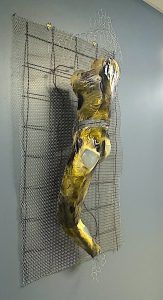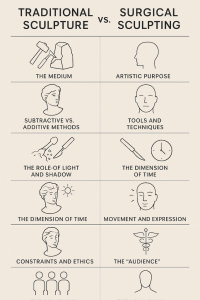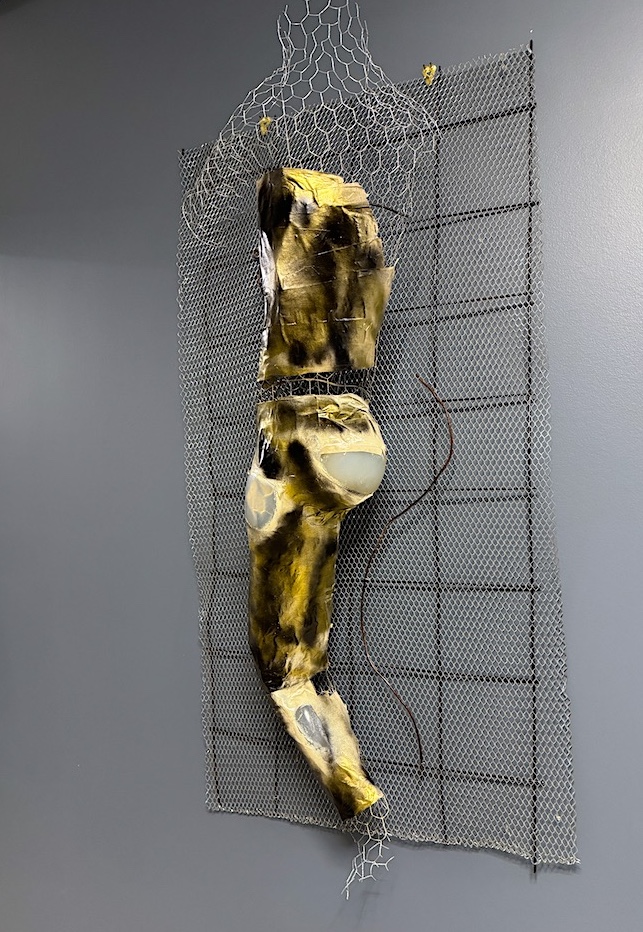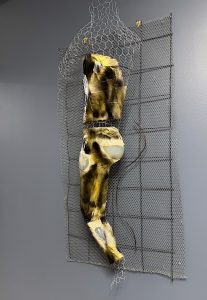
How does Traditional Sculpture compare to Surgical Sculpting? A side by side comparison of them was evaluated across philosophy, technique, medium, and outcomes.
1. The Medium
Traditional Sculpture
- Stone, clay, metal, wood, plaster
- Material is inert—once shaped, it stays that way
- Medium has predictable behavior
Surgical Sculpting
- Skin, fat, fascia, muscle, cartilage, bone
- Tissue is alive—it heals, swells, contracts, ages
- Behavior is partially predictable but always individual
Key difference:
A sculptor imposes form onto a stable medium; a surgeon creates form knowing the medium will continue to change for weeks, months, or years.
2. Artistic Purpose
Traditional Sculpture
- Create something new
- Express an idea, emotion, or representation
- Aesthetic ideals may be personal or cultural
Surgical Sculpting
- Refine what already exists
- Enhance harmony, restore balance, or correct deformity
- Aesthetic goals must match:
- patient identity
- anatomical constraints
- natural appearance
Key difference:
Sculpture creates identity; surgery must preserve it.
3. Subtractive vs. Additive Methods
Traditional Sculpture
- Subtractive: carving stone, chiseling
- Additive: building clay, casting metal
- Methods can be extreme—large removals are possible
Surgical Sculpting
- Subtractive: fat removal, cartilage reduction, skin excision
- Additive: fat grafting, fillers, implants, cartilage grafts
- Changes must be delicate and safe—millimeters matter
Key difference:
In surgery, the “material” has functional importance—removing too much or adding too much can impair movement, breathing, symmetry, etc.
4. Tools and Techniques
Traditional Sculpture
- Chisels, rasps, modeling tools, hammers
- Tools primarily manipulate shape and texture
Surgical Sculpting
- Scalpels, cannulas, osteotomes, sutures, electrocautery
- Tools must also protect tissue viability, vessels, nerves
- Operations occur in hidden planes beneath the surface
Key difference:
Surgical tools sculpt through layers, not just on the external surface.
5. The Role of Light and Shadow
Traditional Sculpture
- Light defines form, transitions, edges, and depth
- Sculptors often rotate the object to study highlights
Surgical Sculpting
- Surgeons use the same principles:
- cheek highlights
- jawline shadow
- nasal dorsum light reflection
- Many techniques intentionally redirect light
(e.g., rhinoplasty dorsal contour shaping)
Key similarity:
Both arts sculpt how light interacts with the surface, not just the surface itself.
6. The Dimension of Time
Traditional Sculpture
- The form is fixed once completed
- Time only affects aging of the material, not the design
Surgical Sculpting
- The result continues to evolve:
- swelling resolution
- scar maturation
- fat resorption or survival
- changes with aging
Key difference:
The surgeon must envision the healed result, not just the immediate one on the operating table.
7. Movement and Expression
Traditional Sculpture
- Static—expression is frozen
- Movement is implied through posture or lines
- No functional constraints
Surgical Sculpting
- Dynamic—every feature moves:
- smiling
- talking
- blinking
- muscular tension
- The sculpted form must remain natural in expression
Key difference:
Surgical sculpting must work in motion, not just at rest.
8. Constraints and Ethics
Traditional Sculpture
- Limited only by imagination
- Can distort proportions for effect
- No ethical constraints beyond artistic intent
Surgical Sculpting
- Guided by:
- anatomy
- safety
- patient psychology
- long-term functionality
- do-no-harm ethics
Key difference:
Surgical art must balance aesthetics with human well being.
9. The “Audience”
Traditional Sculpture
- Audience is the public
- The work exists independently of the viewer
Surgical Sculpting
- The “audience” is the individual patient
- The result exists as part of their identity
- Success is defined by personal satisfaction, not external praise
10. The Final Form
Traditional Sculpture
- Exists as an independent object
- Can be displayed, sold, preserved
- Detached from the creator after completion
Surgical Sculpting
- Lives within the patient
- Changes with aging, weight fluctuation, lifestyle
- Surgeon’s work becomes part of a living person’s story
What They Share
Despite the differences, both forms of sculpting rely on:
- Proportion and geometric harmony
- Study of anatomy
- Sensitivity to form and contour
- Mastery of material behavior
- Skilled hands guided by an aesthetic mind
- The ability to visualize the final outcome before starting
In Essence

Surgical sculpture alters living form while preserving identity, function, and humanity.
One is art imposed on matter.
The other is art integrated into biology.
Dr. Barry Eppley
World-Renowned Plastic Surgeon




